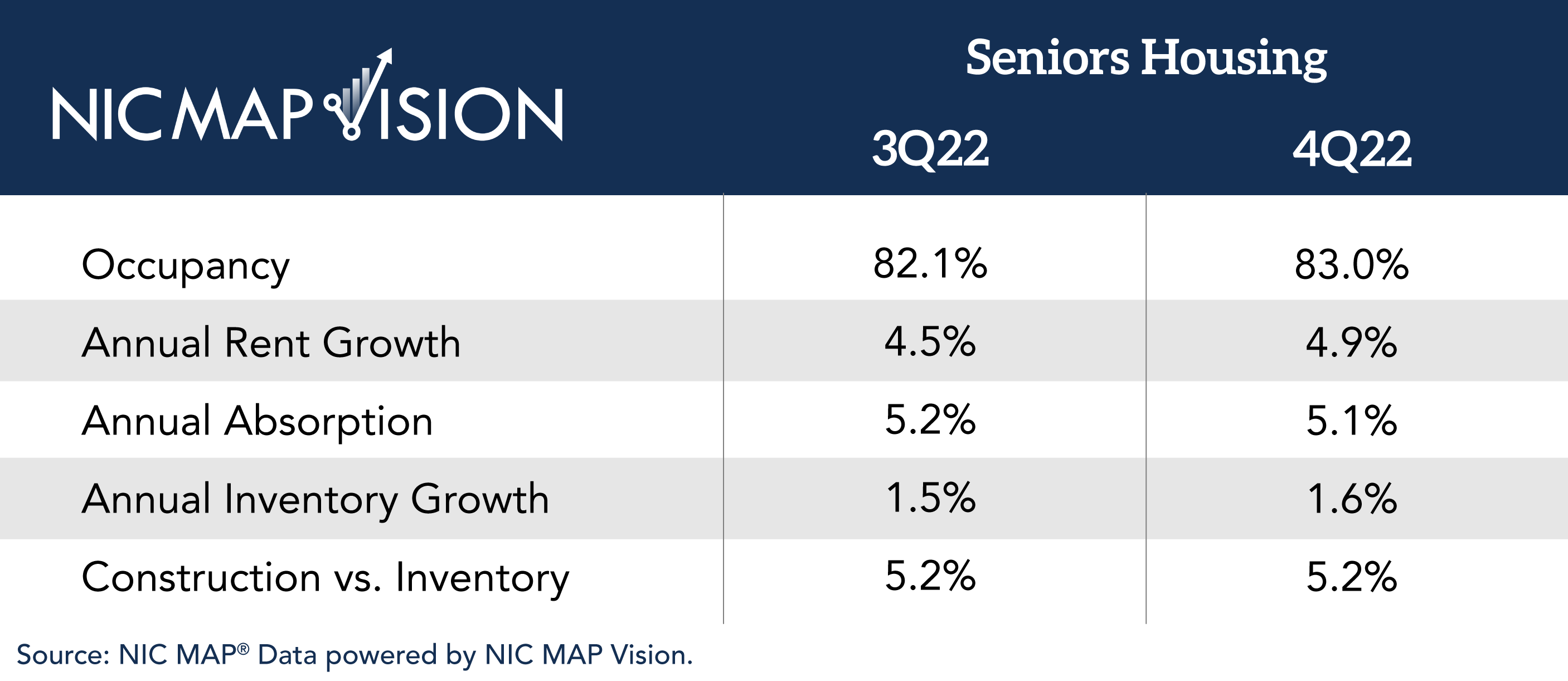More Older Adults Live in Senior Housing than Ever Before, According to Latest NIC MAP Vision Data
The senior housing occupancy rate increased 0.9 percentage point from 82.1% in the third quarter of 2022 to 83.0% in the fourth quarter of 2022, according to data from NIC MAP Vision. The occupancy rate has increased 5.2 percentage points from a pandemic low of 77.8% in the second quarter of 2021.
The senior housing occupancy rate increased for the sixth consecutive quarter due to continued strong demand that outpaced inventory growth. Because new inventory has been added during the pandemic, however, the occupancy rate has not yet reached pre-pandemic levels. On the inventory side, about 3,300 units were added within the 31 NIC MAP Primary Markets during this quarter, while more than 8,600 units were absorbed on a net basis. This robust demand led to a new record high total number of occupied units: within the NIC MAP Primary Markets, the total number of occupied units exceeded 574,900, surpassing its pre-pandemic first quarter 2020 level by nearly 7,000 units.
“More older adults than ever before are now residents in senior housing properties, which speaks to the tremendous need for senior housing and care services,” said Chuck Harry, NIC’s chief operating officer. “The demand from aging adults seeking senior housing and care is on the rise, and the industry continues to meet that need.”
The trend of high demand and slow inventory growth has been consistent throughout 2022. Fewer than 11,000 units were added within the NIC MAP Primary Markets this year, the weakest inventory growth since 2014. This contrasted with robust demand, with net absorption for the year registering a record 27,845 units. Combined, these conditions allowed the occupancy rate to rise 2.8 percentage points since the beginning of 2022.
Construction starts were relatively weak at 3,013 units in the fourth quarter, continuing the slower pace seen in the third quarter. Total units under construction equaled 35,719 units, the fewest units under construction since 2015. For 2022, starts totaled 14,665 units, weaker than in 2021, but stronger than in 2020.
“Development activity slowed sharply in the second half of 2022 as the rise in interest rates and a more stringent lending environment slowed loan issuance,” said Beth Burnham Mace, NIC’s chief economist. “With higher interest rates expected in the early months of 2023, slower development pipelines are likely to continue, which could continue to impact inventory growth and therefore positively affect occupancy rates.”
Occupancy improved across all property types. Assisted living had the largest quarterly gain, with robust demand pushing the total number of occupied assisted living units to their highest level ever.
More specifically:
- Assisted living occupancy increased 1.1 percentage point to 80.7%, up 6.8 percentage points from its pandemic low of 73.9% in the second quarter of 2021, but still below the pre-pandemic level of 84.6%.
- Independent living occupancy increased 0.6 percentage point to 85.2%, up 3.6 percentage points from its pandemic low of 81.6% in the second quarter of 2021, but still below the pre-pandemic level of 89.6%.
- Nursing care occupancy increased 0.7 percentage point to 80.0%, up 6.0 percentage points from its pandemic low of 74.0% in the first quarter of 2021, but still below the pre-pandemic level of 86.6%.
Twenty-eight of the 31 NIC MAP Primary Markets saw occupancy increases in the fourth quarter of 2022. Boston (88.9%), Baltimore (86.7%), and Portland, OR (86.2%) had the highest senior housing occupancy rates within NIC MAP’s Primary Markets, and Houston (77.9%), Atlanta (79.0%), and Cleveland (79.4%) had the lowest rates.
Asking rental rates for senior housing across the NIC MAP Primary Markets saw their largest increase since NIC MAP Vision began reporting the data in 2006, having increased by 4.9% on a year-over-year basis in the fourth quarter.
A summary of the NIC MAP Market Fundamentals Data, released by NIC MAP Vision, is below. The Market Fundamentals report will be available at 4:30 p.m. ET on Thursday, January 5.
###
About the National Investment Center for Seniors Housing & Care
The National Investment Center for Seniors Housing & Care (NIC), a 501(c)(3) organization, works to enable access and choice by providing data, analytics, and connections that bring together investors and providers. The organization delivers the most trusted, objective, and timely insights and implications derived from its analytics, which benefit from NIC’s affiliation with NIC MAP Vision, the leading provider of comprehensive market data for senior housing and skilled nursing properties. NIC events, which include the industry’s premiere conferences, provide sector stakeholders with opportunities to convene, network, and drive thought-leadership through high-quality educational programming. For more information, visit NIC’s website and follow NIC on Twitter, LinkedIn, and Facebook.
About NIC MAP Vision
NIC MAP Vision is a leading provider of comprehensive market data for the seniors housing and care sector. NIC MAP Vision brings together two strong, well-respected, and complimentary teams and platforms – the market-leading NIC MAP® Data Service (NIC MAP) and VisionLTC’s best-in-class market research analysis platform. For more information, visit NIC MAP Vision’s website.
